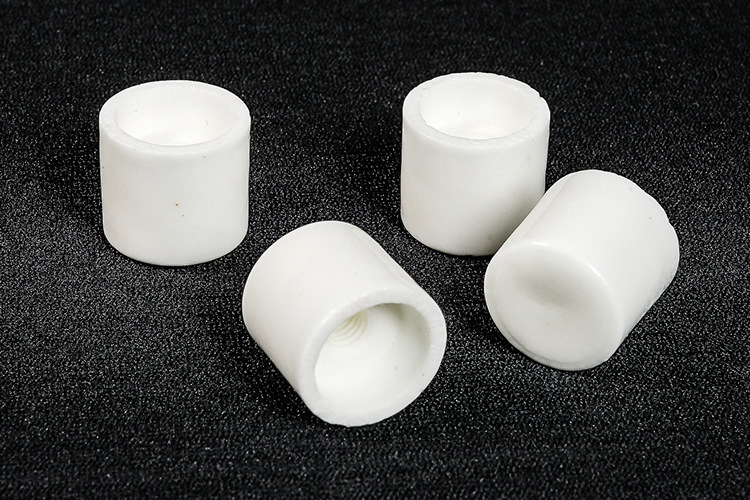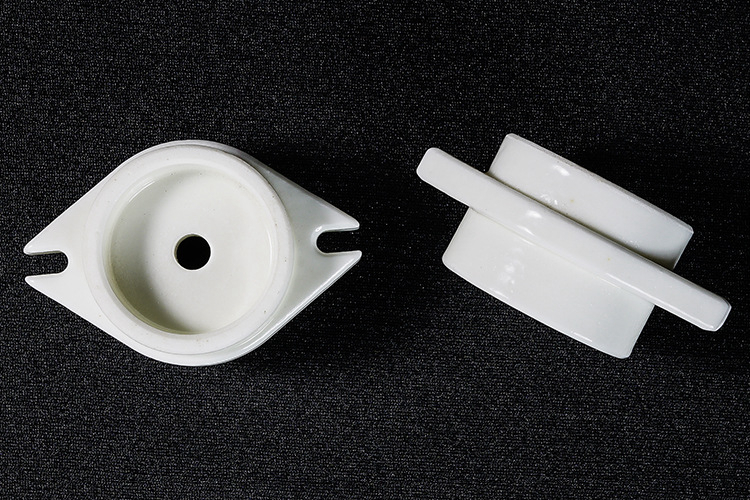In advanced manufacturing, ceramic materials stand out for their exceptional properties, including high heat resistance, durability, and strength. These characteristics make ceramics indispensable in aerospace, automotive, electronics, and healthcare industries. Manufacturers use specialized techniques to mold these robust materials into precise, complex shapes. Among these, Ceramic Hot Pressing and Ceramic Injection Molding are prominent methods. Each offers distinct advantages and caters to different manufacturing requirements.
Understanding Ceramic Hot Pressing Molding
What is Ceramic Hot Pressing Molding? Ceramic Hot Pressing Molding is a fabrication process designed to shape ceramic materials under heat and pressure application. This technique is distinguished by its ability to produce highly dense and robust ceramic parts, which are crucial for high-performance applications across various industries.

Detailed Explanation of the Process:
Material Preparation:
The process begins with the preparation of ceramic powders. These powders are often mixed with a small amount of binder or additives to enhance flow and cohesion during molding.
Molding Process:
The ceramic powder is placed in a mold cavity shaped as the desired final product. The mold is then subjected to high temperatures and pressures. The heat helps reduce the viscosity of the ceramic material, allowing it to flow and fill the mold cavity. In contrast, the pressure helps compact the material, reduce porosity, and increase density.
The temperature and pressure parameters depend on the type of ceramic material used. Typically, temperatures range from 1000°C to 2000°C, and pressures vary from 15 to 40 MPa.
Cooling and Demolding:
After the material has been formed in the mold, it can cool under controlled conditions to prevent cracks or warping. Once cooled, the dense, hardened part is removed from the mold. The final part may undergo additional processes like machining or grinding to achieve precise dimensions and surface finish.
Advantages of Using Ceramic Hot Pressing Molding:
High Material Density: This process achieves near-theoretical density, minimizing porosity and enhancing mechanical properties like strength and hardness.
Excellent Mechanical Properties: Parts produced are dense and have excellent wear resistance and mechanical strength, making them ideal for severe wear and high-load applications.
Efficient Material Utilization: Ceramic Hot Pressing typically results in minimal material wastage, which is crucial for cost-effectiveness when using expensive ceramics.
Typical Applications and Industries That Benefit:
Aerospace: Components such as insulators, thermal shields, and other critical parts require high material integrity.
Automotive: Uses include sensors, high-temperature engine components, and ceramic bearings.
Electronics: For substrates and insulators that must withstand high operational temperatures.
Medical Devices: Used to produce durable, biocompatible dental and orthopedic implants.
Ceramic Hot Pressing Molding stands out for its ability to produce solid and dense components, which is crucial for applications where material performance under stress, temperature, and wear is critical. In the next section, we will explore Ceramic Injection Molding to understand how it compares and contrasts with this process, offering a broader view of ceramic manufacturing options.
Exploring Ceramic Injection Molding (CIM)
What is Ceramic Injection Molding? Ceramic Injection Molding (CIM) is a sophisticated manufacturing technique that combines the versatility of injection molding with the unique properties of ceramics. This process enables the production of complex, high-precision ceramic components suitable for various high-performance applications.

Step-by-Step Breakdown of the CIM Process:
Material Preparation:
The process starts with the blending of ceramic powders with a thermoplastic binder, creating a feedstock that is both moldable and stable. This mixture ensures that the ceramic particles are evenly distributed and flow smoothly during injection.
Injection into a Mold:
The feedstock is then heated and injected into a mold under high pressure, similar to plastic injection molding. This step allows for creating complex shapes and intricate details that would be difficult or impossible to achieve with traditional ceramic forming methods.
Binder Removal:
After molding, the next crucial step is the removal of the binder, a process known as debinding. It can be done through various methods, such as thermal debinding, where the part is slowly heated to burn off the binder without affecting the shape of the ceramic.
Sintering:
Once the binder is removed, the part undergoes sintering at high temperatures. Sintering densifies the part by causing the ceramic particles to fuse, enhancing the final component's mechanical strength and structural integrity.
Benefits of Choosing CIM for Ceramic Part Production:
Complex Geometries and High Precision: CIM allows for producing components with complex shapes and intricate details, maintaining tight tolerances and excellent dimensional accuracy.
Efficient Production of Small to Medium Volumes: This method is highly effective for economically producing small to medium batch sizes, offering high repeatability and consistency.
Excellent Surface Finish: Parts produced via CIM typically have a smooth surface that may require minimal post-processing, reducing overall production times and costs.
Common Applications and Industries Using CIM:
Medical: Ideal for manufacturing surgical tools, implants, and components for medical devices that require high precision and biocompatibility.
Automotive: Used to produce durable components for engines, sensors, and electrical systems that can withstand extreme conditions.
Electronics: Suitable for creating insulators, capacitors, and other critical components that benefit from the electrical insulation properties of ceramics.
Ceramic Injection Molding offers a versatile solution for producing detailed and complex ceramic components, making it a valuable method in industries where precision is paramount. In the next section, we will compare Ceramic Hot Pressing and Ceramic Injection Molding, providing insights into their advantages and ideal applications.
Ceramic Hot Pressing Vs. Ceramic Injection Molding
Comparison of Complexity and Design Capabilities:
Ceramic Hot Pressing Molding:
Complexity: Typically, Ceramic Hot Pressing Molding is better suited for producing simpler shapes with fewer intricate features. The process is well-suited for parts with uniform cross-sections and minimal undercuts.
Design Capabilities: While Ceramic Hot Pressing can accommodate some level of complexity, it may need help with intricate geometries or features that require fine detail. Parts produced through this method often have smoother surfaces and fewer internal features.
Ceramic Injection Molding (CIM):
Complexity: CIM excels in producing highly complex shapes and intricate features due to its ability to replicate detailed mold cavities accurately. This process allows for creating parts with undercuts, thin walls, and complex internal geometries.
Design Capabilities: With CIM, designers can explore complex designs and incorporate features such as threads, holes, and internal channels. The process can produce parts with precise surface finishes and intricate details, making it ideal for applications requiring high levels of customization.
Summary: Ceramic Injection Molding surpasses Ceramic Hot Pressing Molding in complexity and design capabilities. While Ceramic Hot Pressing suits simpler shapes and uniform parts, Ceramic Injection Molding offers greater versatility and flexibility, producing highly complex components with intricate features and precise details. Depending on the specific requirements of the part and the desired level of complexity, manufacturers can choose between these two methods to achieve the best results for their applications.
Material Properties and Impact on End-Use Performance:
Ceramic Hot Pressing Molding:
Material Properties: Ceramic parts produced through hot pressing typically exhibit exceptional material properties, including high density, strength, and hardness. The process enables the creation of parts with near-theoretical density, minimizing porosity and ensuring uniform material properties throughout the component.
Impact on End-Use Performance: The superior material properties achieved through Ceramic Hot Pressing Molding make it suitable for applications requiring high mechanical strength, wear resistance, and thermal stability. Components produced via this method excel in demanding environments where reliability and performance are critical, such as aerospace, automotive, and industrial machinery.
Ceramic Injection Molding (CIM):
Material Properties: CIM produces ceramic parts with excellent mechanical properties. However, they may not reach the same level of density and strength as those produced through hot pressing. The presence of residual porosity, albeit minimal, can affect material properties such as strength and thermal conductivity.
Impact on End-Use Performance: While CIM parts may not match the density and strength of hot-pressed ceramics, they still offer impressive performance characteristics suitable for a wide range of applications. CIM parts are often chosen for their ability to achieve complex geometries and intricate features, making them ideal for applications where design flexibility and customization are paramount, such as medical devices and electronic components.
Summary: Regarding material properties and impact on end-use performance, Ceramic Hot Pressing Molding produces parts with superior mechanical properties, including high density, strength, and hardness, making them well-suited for demanding applications. On the other hand, Ceramic Injection Molding offers excellent performance characteristics and design flexibility, albeit with slightly lower material density and strength compared to hot pressing. The choice between these methods depends on the specific requirements of the application and the desired balance between material properties and design complexity.
Production Volume Considerations and Cost-Effectiveness:
Ceramic Hot Pressing Molding:
Production Volume: Ceramic Hot Pressing Molding is typically more suited to low to medium production volumes. While it can produce high-quality parts with excellent material properties, the process is relatively time-consuming. It is more efficient for large-scale production runs.
Cost-Effectiveness: While Ceramic Hot Pressing Molding offers superior material properties, it may incur higher initial tooling and setup costs than other methods. Additionally, the longer processing times and limited scalability can affect the overall cost-effectiveness of the process, particularly for high-volume production.
Ceramic Injection Molding (CIM):
Production Volume: CIM is well-suited for both low-volume and high-volume production. The process allows for efficient production of complex parts with minimal material wastage, making it cost-effective for small-scale and large-scale manufacturing runs.
Cost-Effectiveness: While CIM may involve higher upfront tooling costs than traditional ceramic forming methods, it offers significant cost savings regarding material utilization and production efficiency. The ability to produce intricate parts with minimal post-processing requirements further enhances the overall cost-effectiveness of the process.
Summary: When considering production volume considerations and cost-effectiveness, Ceramic Injection Molding (CIM) often outperforms Ceramic Hot Pressing Molding. CIM offers greater scalability and efficiency, making it suitable for low-volume and high-volume production runs. While Ceramic Hot hot-pressing molding may provide superior material properties, its longer processing times and limited scalability can impact cost-effectiveness, particularly for large-scale production. Ultimately, the choice between these methods depends on the specific production requirements, budget constraints, and desired balance between material properties and production efficiency.
Decision-Making Factors for Manufacturers Choosing Between the Two Methods:
Complexity of the Part Design:
Ceramic Hot Pressing Molding (CHPM): Suitable for simpler shapes with fewer intricate features.
Ceramic Injection Molding (CIM): Ideal for highly complex designs with intricate features, including undercuts, thin walls, and internal channels.
Material Properties and Performance Requirements:
CHPM: Produces parts with superior material properties, including high density, strength, and hardness, making them suitable for demanding applications.
CIM: Offers excellent performance characteristics and design flexibility, albeit with slightly lower material density and strength compared to hot pressing. Suitable for applications requiring intricate designs and customization.
Production Volume and Scalability:
CHPM: More suited to low to medium production volumes due to longer processing times and limited scalability.
CIM: Well-suited for both low-volume and high-volume production runs, offering efficiency and scalability.
Cost Considerations:
CHPM: This may incur higher initial tooling and setup costs, as well as longer processing times, impacting overall cost-effectiveness, particularly for large-scale production.
CIM: Offers significant cost savings in terms of material utilization and production efficiency, making it cost-effective for both small-scale and large-scale manufacturing runs.
Application-Specific Requirements:
CHPM: Best suited for applications requiring superior material properties and performance under extreme conditions, such as aerospace, automotive, and industrial machinery.
CIM: Suitable for applications requiring intricate designs, customization, and fast turnaround times, such as medical devices, electronics, and consumer products.
Summary: The choice between Ceramic Hot Pressing Molding (CHPM) and Ceramic Injection Molding (CIM) depends on several factors, including the complexity of the part design, material properties, and performance requirements, production volume considerations, cost considerations, and application-specific requirements. While CHPM offers superior material properties and performance, CIM provides greater design flexibility, scalability, and cost-effectiveness. Manufacturers must carefully evaluate these factors to determine the most suitable method for their application and production needs.
Ceramic Parts Manufacturing
We offer free material selection and consultative design services from beginning to end. No MOQs, Rapid prototyping, and mass production are our strengths.
评论
发表评论